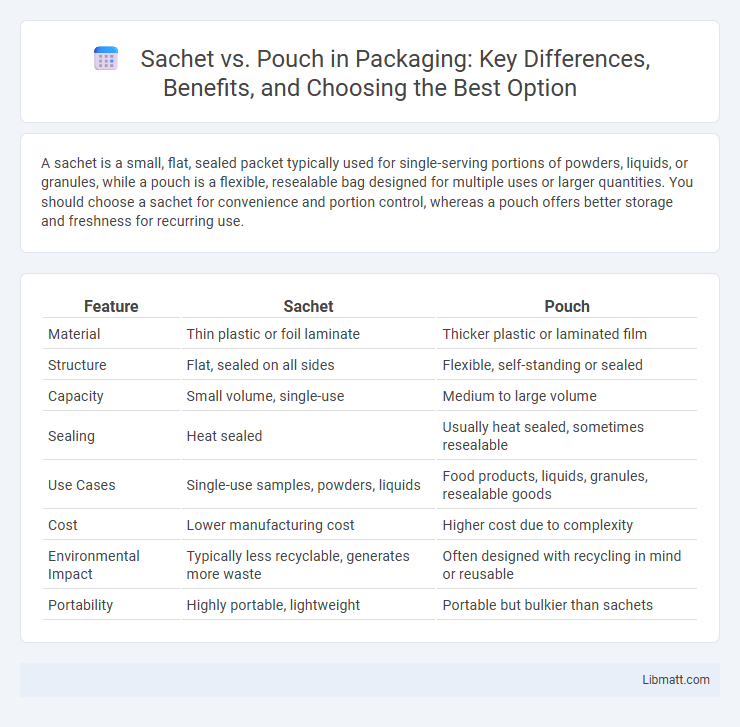A sachet is a small, flat, sealed packet typically used for single-serving portions of powders, liquids, or granules, while a pouch is a flexible, resealable bag designed for multiple uses or larger quantities. You should choose a sachet for convenience and portion control, whereas a pouch offers better storage and freshness for recurring use.
Table of Comparison
| Feature | Sachet | Pouch |
|---|---|---|
| Material | Thin plastic or foil laminate | Thicker plastic or laminated film |
| Structure | Flat, sealed on all sides | Flexible, self-standing or sealed |
| Capacity | Small volume, single-use | Medium to large volume |
| Sealing | Heat sealed | Usually heat sealed, sometimes resealable |
| Use Cases | Single-use samples, powders, liquids | Food products, liquids, granules, resealable goods |
| Cost | Lower manufacturing cost | Higher cost due to complexity |
| Environmental Impact | Typically less recyclable, generates more waste | Often designed with recycling in mind or reusable |
| Portability | Highly portable, lightweight | Portable but bulkier than sachets |
Introduction to Sachets and Pouches
Sachets and pouches are versatile packaging solutions designed to protect and preserve products such as food, cosmetics, and pharmaceuticals. Sachets are typically small, lightweight packets made from flexible materials, ideal for single-use portions, while pouches offer resealable options with greater durability and volume capacity. Your choice between sachet and pouch packaging depends on product requirements, convenience, and consumer preferences.
Defining Sachets and Pouches
Sachets are small, sealed packets typically made from paper, foil, or plastic, designed to hold single-use quantities of products like powders, liquids, or granules. Pouches are flexible, resealable containers made from laminated materials, offering durability and multiple-use convenience for items such as snacks, liquids, or pharmaceuticals. Understanding the key differences in size, material, and reusability can help you select the right packaging solution for your product needs.
Key Differences Between Sachets and Pouches
Sachets are small, single-use packets typically made from flexible materials like foil or paper, designed for lightweight, powdered, or liquid products such as spices, shampoos, or sauces. Pouches, on the other hand, are larger, resealable packaging options often made from laminated plastic films, used for bulkier items like snacks, pet food, or frozen goods, offering durability and extended freshness. Key differences include size, resealability, material strength, and common product applications, with sachets favored for convenience and pouches chosen for protection and reusability.
Material Comparison: Sachet vs Pouch
Sachets are typically made from lightweight materials like plastic films, foil laminates, or paper, offering cost-effective protection for small portions of liquids or powders. Pouches use more durable, multi-layer materials such as laminated plastics, foil, or biodegradable films, providing enhanced barrier properties and resealability for longer shelf life. The material choice directly impacts packaging strength, flexibility, and product preservation between sachets and pouches.
Packaging Efficiency and Convenience
Sachets offer compact packaging with precise portion control, making them highly efficient for single-use products and minimizing waste, while pouches provide resealable options that enhance convenience for multiple uses and extended product freshness. Pouches typically use flexible materials that reduce storage and transportation costs due to their lightweight and space-saving design. Both packaging types improve user experience, but sachets excel in cost-effective distribution whereas pouches prioritize consumer convenience and product longevity.
Environmental Impact and Sustainability
Sachets typically use multilayer laminates that are difficult to recycle, resulting in higher environmental impact compared to pouches, which often employ recyclable or biodegradable materials. Pouches reduce plastic waste due to their flexible design and smaller material usage, supporting greater sustainability in packaging. Choosing a pouch over a sachet can significantly lower your product's carbon footprint and enhance eco-friendly brand appeal.
Cost Analysis: Sachet vs Pouch
Sachets generally offer lower production and material costs compared to pouches, making them ideal for high-volume, low-cost packaging needs. Pouches, while more expensive due to thicker materials and complex sealing processes, provide enhanced durability and resealability that can justify the higher initial investment through extended product shelf life. Cost efficiency for sachets versus pouches ultimately depends on factors such as product type, packaging size, and consumer convenience preferences.
Consumer Preferences and Market Trends
Consumer preferences show a growing shift towards pouches due to their resealability, portability, and eco-friendly materials, enhancing convenience for on-the-go lifestyles. Market trends indicate rising demand for sustainable packaging, with pouches offering reduced plastic use and better recyclability compared to traditional sachets. Brands targeting millennials and Gen Z favor pouches to align with environmental values and premium product perceptions, driving increased pouch market penetration globally.
Applications and Industry Uses
Sachets and pouches serve diverse applications across industries such as food, pharmaceuticals, cosmetics, and agriculture, with sachets typically used for single-dose packets of spices, medicines, or samples. Pouches, offering resealable or stand-up features, are favored for longer-term storage of products like snacks, pet food, and liquid detergents, enhancing convenience and shelf life. Your choice between sachet and pouch packaging impacts product presentation, preservation, and user experience in competitive markets.
Choosing Between Sachet and Pouch for Your Product
Choosing between sachet and pouch packaging depends on product type, volume, and consumer convenience. Sachets are ideal for single-use, small quantities often favored in samples, powders, or condiments, while pouches provide resealable options suitable for larger portions and longer shelf life. Consider factors like durability, material compatibility, and branding space to optimize packaging effectiveness and customer experience.
Sachet vs pouch Infographic

 libmatt.com
libmatt.com